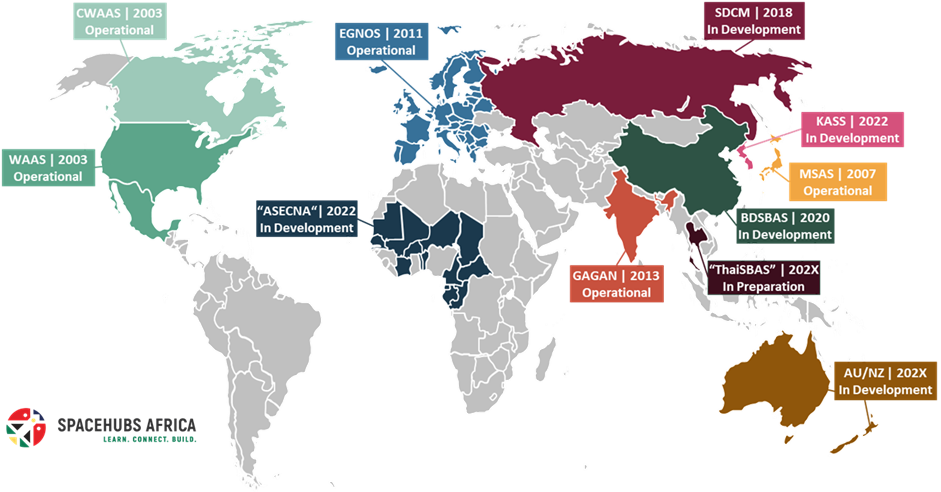How Africa can benefit from Satellite-based Augmentation Systems
Satellite-Based Augmentation Sýstems (SBAS) augment Global Navigation Satellite Systems (GNSS) such as GPS and Galileo. At a basic level, SBAS provide correction data on the ranging and integrity of satellite signals. This allows users to have more confidence in their data, and fewer position errors. Errors due to the ionosphere signal delay, satellite clocks, and satellite position are all targeted by SBAS. SBAS are primarily used by civil aviation authorities, and the systems can cover regional and continental scale distances.
While some of the more northern African regions have already been targeted and have systems that are under development, such as the Agency for Aerial Navigation Safety in Africa and Madagascar (ASECNA) system, to date none have yet materialised.
Figure 1: Satellite-based augmentation systems worldwide
The potential benefits of SBAS are extensive, particularly in Africa, and touch on several different domains. The provision of SBAS allows areas currently not equipped with the traditional navigation aids to be covered, thereby opening-up airports and isolated regions, saving on local investments (reduced need for ground facilities in the airports and maintenance), and creating more efficient air transportation. The impact on aviation could help open opportunities on the commercial side.
The impact of the ionosphere in the sub-Saharan region, is an important factor impacting the use of GNSS, but also stimulating the use of SBAS. GNSS operations and Approach Procedures with Vertical Guidance (APV) can be seriously affected in their range accuracy due to the high values, large gradients and variability in the total electron content, which disperse the signals. The danger posed by the ionospheric effect on GNSS based aviation operations was similarly recognised by ICAO who stated in 2012 [1] that “APV operations, ionospheric delay corrections and associated integrity bounds must be obtained from a SBAS”.
On the aviation side, according to the International Air Transport Association (IATA), Africa is set to become one of the fastest growing aviation regions in the next 20 years with an annual growth of nearly 5% [2]. This annual growth means an aggregate growth of around 150%, so more than double the current capacity. Allied with this growth are initiatives on the continental level driven by the African Union according to the AU Agenda 2063. The Single African Air Transport Market (SAATM) is a flagship project that aims to create a single unified air transport market in Africa. The SAATM, launched in January 2018, will enable eligible airlines or carriers to fly between countries using only a simple prior notification procedure. To date, 27 African countries have signed up, including South Africa, Eswatini, Botswana, Zimbabwe, Kenya and Rwanda in the South(ern) African region (representing 52% of air passenger volume and 24% of GDP in sub-Saharan Africa).
Status and forecast of aviation indicators in Africa [3]
Given these trends towards further integration and growth in aviation, safety and security standards become increasingly critical. The African Civil Aviation Commission has been working with the ICAO under its ‘No Country Left Behind’ initiative to improve civil aviation safety and security in Africa through the AFI Comprehensive Implementation Plan for Aviation Safety in Africa (AFI SAFPLAN) and the AFI Comprehensive Regional Implementation Plan for Aviation Security and Facilitation in Africa (AFI SECFAL) programmes.
Having said that, the reality is that airport infrastructure in most African countries is outdated and not built to serve the growing volume of passengers or cargo. At the same time, it is recognised that Africa is still lagging behind in terms of international aviation safety standards. While Africa accounted for about 4% of the global air traffic in 2018[4], it accounted for 28% of the worldwide fatal aircraft accidents in the same period[5]. This is exactly where SBAS can help by offering a cost-effective alternative to ground-based navaids and all-weather landing capabilities.
Kwaku Sumah
Kwaku has been active in the space industry since 2016, working as a consultant for European space institutions and companies. He has worked on projects across the entire space value chain, including analysis on downstream markets, space debris evolution, planetary defence, and the launch market; as well as an assessment of the European financing landscape and due diligence on space companies. Most recently he worked as the project manager for Galileo Green Lane, an EU response to COVID-19 leveraging GNSS.
[1] ICAO, First Meeting of Ionospheric Studies Task Force, Tokyo, February 2012
[2] https://oecd-development-matters.org/2018/10/29/unlocking-africas-aviation-potential/, 2018
[3] World Bank data 2019
[4] Boeing, Commercial Market Outlook 2019-2038
[5] Aviation Safety Network


![Status and forecast of aviation indicators in Africa [3]](https://images.squarespace-cdn.com/content/v1/5da32b6e1e46cf0ee65ad545/1608840353302-B5ZKXOBC3DG7ND5XC72R/Status+and+forecast+of+aviation+indicators+in+Africa)
